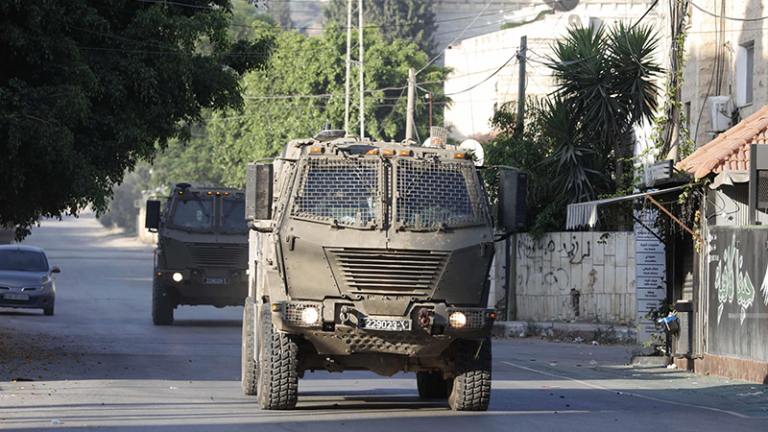
The Jenin refugee camp sits adjacent to the Palestinian city of Jenin in the north of the occupied West Bank. The camp’s registered population numbers around 24,000, and its location—a relatively short distance from the 1967 line, about 5 kilometers—means that Palestinian resistance activity there draws extra attention from the Israeli military. Although assaults on the camp are regularly carried out in order to crush Palestinian resistance, the full scale invasion that took place over the past couple of days has brought the Israeli military’s engagement in the camp to a new level, one that has drawn many comparisons to its onslaught on Palestinian cities in 2002.
Changing Battlefield Dynamics
In recent years, Palestinian resistance activity has continued to grow, particularly in the northern part of the West Bank, as the Palestinian Authority’s (PA) power recedes. The PA, which is supposed to work with the Israeli military on security coordination, seems to be increasingly unable or unwilling to do this. In fact, Palestinian President Mahmoud Abbas has suspended security cooperation with Israel following the attack on Jenin. There is little doubt that the failures of the PA are a product of a lack of both capacity and will. The PA has experienced a constant decline in legitimacy, as well as a decades-long budget crisis. There have also been instances in the last year of PA security forces’ participation in exchanges of fire with the Israeli military, signaling a weakening control over forces in the PA, particularly in the north of the West Bank.
While this general atmosphere of increased, if still sporadic, armed resistance to Israeli military control is an important context for this most recent Israeli operation, a more immediate and perhaps more significant set of events explains the Israeli military’s decision to carry out the multiday raid into the refugee camp.
Whatever the next raid looks like, there is little doubt that the battlefield dynamics have shifted.
About two weeks before the attack started, the Israeli military was conducting a more routine raid into the camp in an effort to arrest or kill wanted Palestinian fighters. However, the Israeli troops were surprised by a significant explosion, and additional military support was needed to ensure their evacuation and tend to their wounded, as several Israeli soldiers were harmed in the ambush. After the attack on several military vehicles, the army used helicopters, drones, and reinforcement troops to establish control over the area, even firing a missile from a helicopter, the first time the Israeli military has done so in the West Bank in roughly 20 years.
For the Israeli military, which seeks to maintain freedom of action for its soldiers in all parts of Palestinian towns and cities without sustaining casualties, this was a nightmare scenario. Their military operations are always carefully planned to allow for the safest possible entry and exit for their soldiers into centers of Palestinian resistance. The ambush undoubtedly caught the military by surprise and triggered a sense of shock. It also set the stage for the large-scale raid that would take place two weeks later, which was aimed at ensuring freedom of action for Israeli troops in Jenin by trying to eliminate as many tools of resistance as possible, including the improvised explosives which were used in the ambush.
How Much Has Really Changed?
Israeli troops withdrew from the Jenin refugee camp after nearly 48 hours of operations. They left in their wake great destruction of civilian infrastructure, including roads, civilian vehicles, and hospitals. The Israeli military killed 12 Palestinians and injured roughly 100 others, and at least one Israeli soldier was killed. The military claims to have apprehended several Palestinian fighters, but far short of the numbers they suggested were in the camp. The military also claims to have confiscated improvised explosive devices (IEDs) and security cameras, and discovered tunnels. Before the operation concluded, a Palestinian from Hebron carried out an attack in Tel Aviv in which eight were injured, and a handful of rockets were fired from Gaza as well.
What, if anything, has really changed after the Israeli operation? The first test for answering this question will come when future raids are conducted in Jenin. Will the Israeli military have the same freedom of action it considered tolerable prior to the month of June, or will it continue to encounter ambushes and explosives that can kill Israeli soldiers? Time will provide an answer, but in the interim, Israeli military vehicles will likely be traveling with a different level of caution in the streets of Jenin.
Whatever the next raid looks like, there is little doubt that the battlefield dynamics have shifted. The Israeli military is no longer just confronting Palestinian resistance fighters in the West Bank in an urban warfare setting but is now increasingly facing guerilla tactics like the use of tunnels and IEDs. As Palestinian militants have demonstrated in Gaza, these tools can be destroyed by the Israeli military, but they can also be rebuilt and developed over time to have greater reach and destructive ability. Unlike the more distant Gaza Strip, Jenin is about 40 km closer to Tel Aviv and, more importantly, Jenin’s increased adoption of guerilla tactics could serve as a template for other Palestinian towns across the West Bank.
Multiple Israeli analysts have described the military operation in Jenin as “maintenance,” and much like the phrase “mowing the lawn,” often used to describe periodic Israeli attacks on Gaza, this policy does not envision an end to armed conflict but rather assumes and guarantees its permanence. Jenin may well now go on the Israeli military’s “maintenance” schedule, but as we have witnessed in recent years the time between Israeli operations in Jenin seems to be getting shorter and the level of force used only gets greater.
What This Tells Us about the Future
With the right-wing Israeli government’s escalating settlement expansion in the occupied West Bank, and with violent Israeli settlers terrorizing Palestinians and destroying their property, there is little doubt that Israeli policy will result in escalating conflict with, and resistance from, the Palestinian people. At the same time, the Palestinian Authority’s control continues to show signs of deterioration. The stage is set for a steady increase in armed Palestinian resistance, coupled with the adoption of evolving tactics that present new challenges to the Israeli military. In turn, Israeli policy makers will continue to look to heavier-handed measures like large-scale raids, closures, and sieges around the center of Palestinian resistance in the West Bank.
The maintenance of apartheid is seen by Israel as a preference to all other available options.
All of this is rooted in Israel’s current vision for the future, one in which it is the dominant power from the Jordan River to the Mediterranean without granting equal rights or privileges to the Palestinians who make up half the population. The maintenance of apartheid is not merely an Israeli choice, it is seen as a preference to all other available options. This vision of apartheid will not remain static, however; it can certainly escalate in severity, and the recent raid on the Jenin refugee camp is a sign of things to come.
Despite the obvious warning signs, the United States, Israel’s primary backer and enabler, seems content to watch the situation deteriorate further, knowing full well where it could lead. Further, while Washington’s policy has thus far been focused on helping Israel sustain its apartheid system no matter the increasing cost to Palestinian life, the results of that policy on the ground are likely to make its maintenance harder over time as Americans, particularly Democrats, shift away from supporting Israel. A West Bank filled with several pockets that Israel will increasingly treat like the besieged Gaza Strip will only accelerate this change.
The views expressed in this publication are the author’s own and do not necessarily reflect the position of Arab Center Washington DC, its staff, or its Board of Directors.
Featured image credit: WAFA

